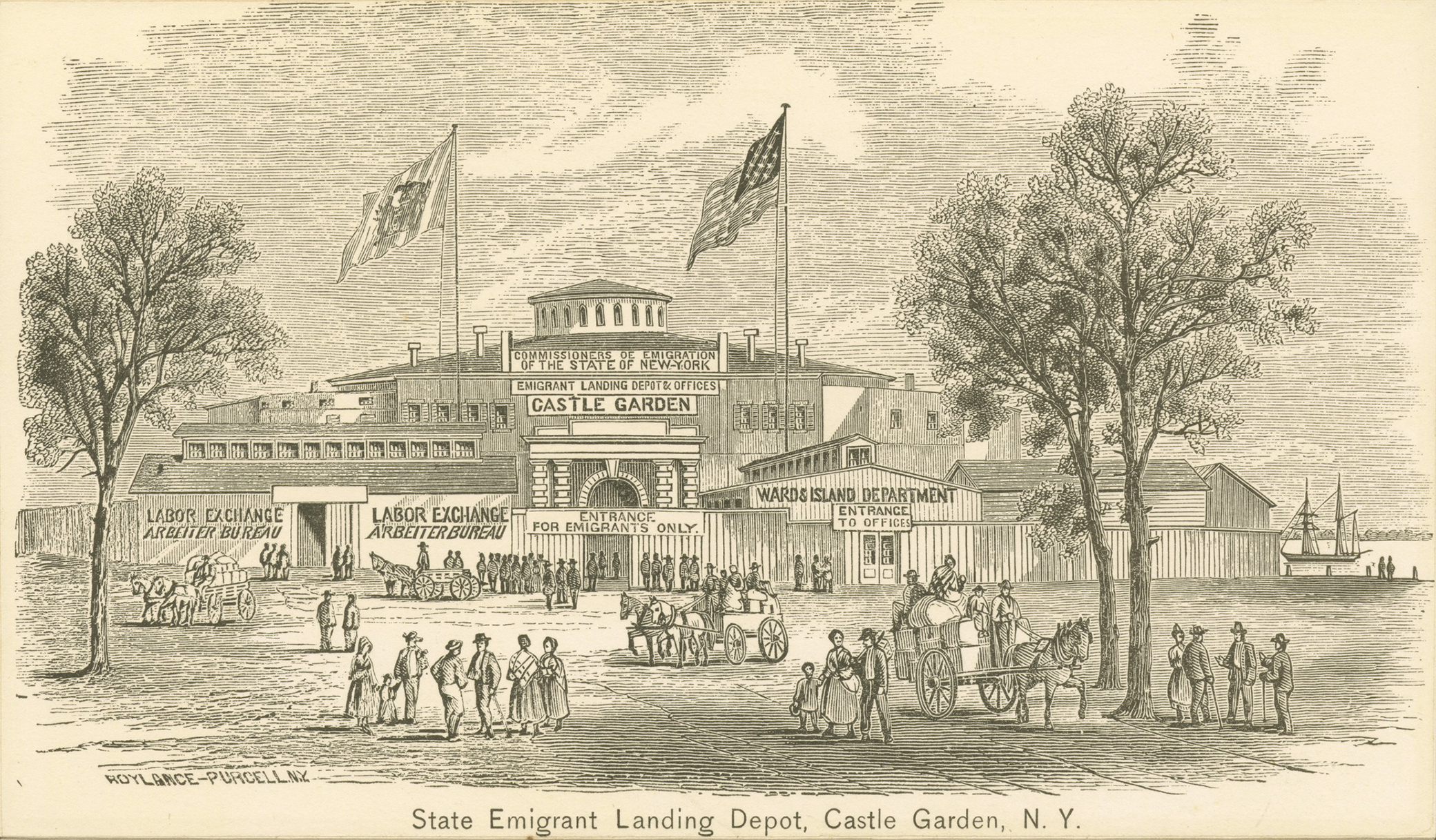
State Emigrant Landing Depot, Castle Garden, New York, 1861. The New York Public Library, The Miriam and Ira D. Wallach Division of Art, Prints and Photographs: Print Collection.
In the four decades before Ellis Island opened in 1892, New York State had a robust immigration regime that attempted to ensure new arrivals’ welfare and integration into American society. While we now think of immigration to the United States as a federal matter, it wasn’t until 1882, when Congress passed an act that put the U.S. Treasury Department in charge, that it was overseen by the national government. (Legislators chose Treasury because they viewed the passenger trade as a form of commerce.) Before the Civil War, politicians from slave states feared increasing federal authority over bodies crossing borders due to the implications such a move might have for the interstate slave trade. The responsibility for immigrants thus stayed with state and local governments. The long-held idea that the U.S. had an “open door” policy before 1882 is simply wrong. Substantial regulatory bureaucracies developed in major receiving states like New York and Massachusetts decades before federalization. Several states had laws for deporting aliens known to be paupers or criminals in their own country, while some slave states, including South Carolina, passed laws forbidding the entry of free blacks.
Thinking about immigration history strictly in terms of exclusion and deportation does not tell the whole story, however. From the 1840s through the 1880s, New York state officials expended considerable time, money, and effort to protect new arrivals at the nation’s biggest port of entry. They treated the sick, provided shelter for the destitute, gave advice on how best to reach final destinations, operated a labor exchange where newcomers could find jobs, aided in reuniting separated families, and provided many other services. They sometimes fell short of their goals but overall did much to ease the difficulties newcomers faced.
In 1847, as waves of Irish and German migration began to crest, New York State lawmakers established the first immigration agency in the country, the State Board of the Commissioners of Emigration (hereafter the Emigration Board—the words emigrant and immigrant were used interchangeably for most of the nineteenth century). The 1840s marked a rise in nativist politics in many states receiving large numbers of immigrants, but New York’s economic and political elites moved in a different direction. Several influential leaders, like governor and U.S. senator William H. Seward, viewed immigrant labor as a key ingredient to the Empire State’s great prosperity, vital to the building of the Erie Canal system and growing railroad network. These leaders did not view immigrants as a threat but as a vulnerable resource worthy of government protection.
Nativists blamed immigrants themselves for their high rate of poverty, while in New York a competing narrative focused on predators known as “immigrant runners.” These quasi-professional thugs waited on the piers and wharves of lower Manhattan and systematically exploited new arrivals via a variety of scams: shepherding immigrants to overpriced boarding houses, stealing luggage or holding it hostage, selling fake railroad or steamboat tickets for journeys into the interior, etc. Respectable New Yorkers viewed runners as part of a disorderly and parasitical class know as “sporting men”—gamblers, hustlers, intimidators, etc.—who appeared to have no legitimate source of income.

Contrary to the Emma Lazarus mythology, most who booked passage through New York in the pre–Civil War decades were not the poorest of the poor even during the height of Irish famine. The least expensive transatlantic steerage fares were £3 or £4 at a time when unskilled laborers earned roughly £8 annually. Immigrants with some means chose New York over cheaper passage to Canada since it offered the fastest and most reliable connections to interior destinations, where land was affordable and labor scarcity meant higher wages. In the 1840s, travelers could take a steamboat up the Hudson River, transfer at Schenectady to a canal boat to Buffalo, and then take a steamboat to multiple points along the Great Lakes (in the early 1850s, the completion of two cross-state railroads took business away from slower canal boats). In 1846 the cost of canal-boat passage from Schenectady to Buffalo was $7.75 with board included (roughly $250 today).
Runners knew that immigrants planned for these travel expenses and plundered these nest eggs with alarming efficiency. State leaders saw these thefts not only as individual wrongs but as squandered future contributions to the economy of the state and nation. In May 1847 the argument that pro-reform politicians made—that new arrivals deserved government protection—persuaded lawmakers to pass a bill establishing the nation’s first immigrant welfare agency with a final vote in the State Assembly of 94–6. “This Law takes the Stranger out of the hands and out of the reach of those who lie in wait to prey upon him,” an editorial in the New York Tribune praised.
In its first years of operation, the Emigration Board built up a modest welfare state. Shipping companies paid a fee for each passenger landed (often called a head tax) out of the fares received, and this fund provided for medical care, refuge, and occasional monetary assistance for immigrants in need. The board supported newcomers who fell into poverty anywhere in the state for a five-year period after arrival and built state-of-the-art hospitals and refuge facilities for immigrants on Ward’s Island in the East River. For its first eight years, the Emigration Board failed to achieve one key goal, however: a protected landing depot where immigrants could be shielded from runners. Property owners along the Manhattan waterfront filed suit against the Emigration Board whenever its officers tried to lease or buy a site, citing fear of pestilential diseases brought by immigrants and the lowering of property values. Shortly after the board’s founding in May 1847, residents in what is now Long Island City in Queens took even more extreme measures. They torched a set of buildings that the board had bought to house sick immigrants, burning the structures to the ground before they could be occupied.
In 1855 Emigration Board officials finally secured a protected waterfront site: an old fort known as Castle Garden, located on the southern tip of Manhattan. Abandoned by the military in the early 1820s, the fort became a public leisure space where vendors sold lemonade and ice cream. In the mid-1840s musical promoters French & Heiser leased the structure from the city, added a roof, and converted it into a theater. The venue catered to New Yorkers’ great love of Italian opera, and in 1850 Swedish singer Jenny Lind had her U.S. debut there. The harbor location provided adequate ventilation for it to remain open during the summer months. Diarist George Templeton Strong wrote, “Perhaps there is hardly so attractive a summer theater in the world as Castle Garden when so good a company is performing there as now,” adding that it offered “ample room; cool sea breeze on the balcony, where one can sit and smoke and listen and look out on the bay studded with lights of anchored vessels, and white sails gleaming.”
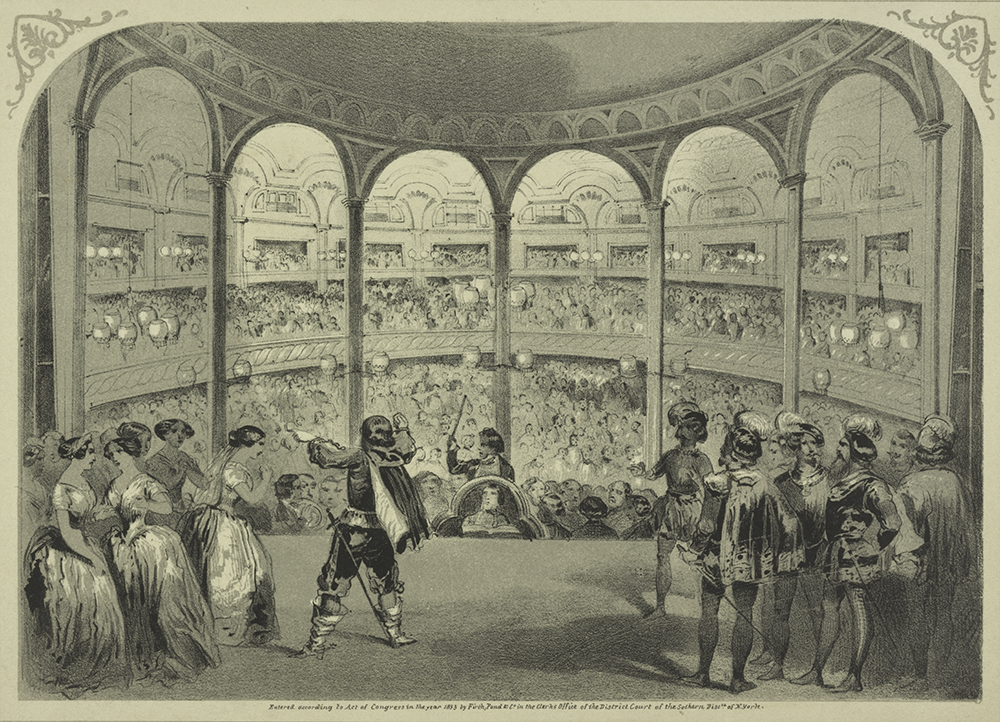
In 1854 Castle Garden’s lease expired, and the city government held an auction to award it to the highest bidder. The theater proprietors lost out to a lawyer named Theodore J. Allen who did not make his intentions public, leaving the press to speculate what might happen to the old fort. Ultimately, through some behind-the-scenes machinations, the Emigration Board secured the lease in May 1855. In an arrangement initially kept secret, the New York Central and Erie railroads agreed to pay the board’s $10,000 monthly rent to the city in exchange for exclusive rights to sell tickets to immigrants within the fort’s walls, keeping out competitors such as the Central Jersey, Pennsylvania, and Lackawanna rail companies. Profit-seeking and human welfare stood in a rare moment of alignment. By early July, the structure’s transformation was well under way despite legal challenges from adjacent property owners to stop it. “Everything of a theatrical character has been taken away,” one journalist noted. “The sound of the hammer and saw is heard where one might suppose the echoes of brilliant music to be lingering.”
On August 3, 1855, Castle Garden opened its doors and processed its first three shiploads of steerage passengers. In contrast to the opening of Ellis Island in 1892, there was no celebration or fanfare. Three days later, an “indignation meeting” of immigrant runners and their allies protested the new facility. Tammany Democrats, who controlled the city government but not the state government, viewed the Emigration Board as an Albany intrusion into municipal affairs, making them sympathetic to the runners’ resentment of the new depot. Some runners served as Tammany “shoulder hitters,” intimidators at the polling place who made sure that people voted for the right candidates in the era before secret ballots. At the protest, Tammany politicians gave speeches, rowdies lit off Roman candles and rockets, and marchers held up banners with messages such as “Remove the Emigrant Depot to Some Island in the Bay” and “Albany Politicians Shall Not Rule New-York.” The Emigration Board had prepared for the protest by bringing three hundred armed police and militiamen inside Castle Garden, but fortunately the protest dispersed without incident.
For the next thirty-five years the immigrant depot generated pride, wonder, and anxiety among New Yorkers. Over eight million immigrants—almost all from Europe—took their first steps on American soil within its thick sandstone walls. Today one can see the skeletal remains of the Castle Garden facility as the Castle Clinton National Park site in the Battery. Surrounding the old fort were several outbuildings, with the whole compound encompassed by a high wooden fence. Before the advent of the skyscraper, the Castle Garden depot, with its squat rotunda roof, was perhaps the most distinctive Manhattan structure viewed from the harbor, as Mark Twain noted in a passage from an 1867 letter describing his ship’s progress toward its dock: “We stood in the biting air of the upper deck and sailed by the snow-covered, wintry looking residences of Staten Island, recognized Castle Garden—beheld the vast city spread beyond, with its palisade of masts, and adorned with its hundreds of steeples.”
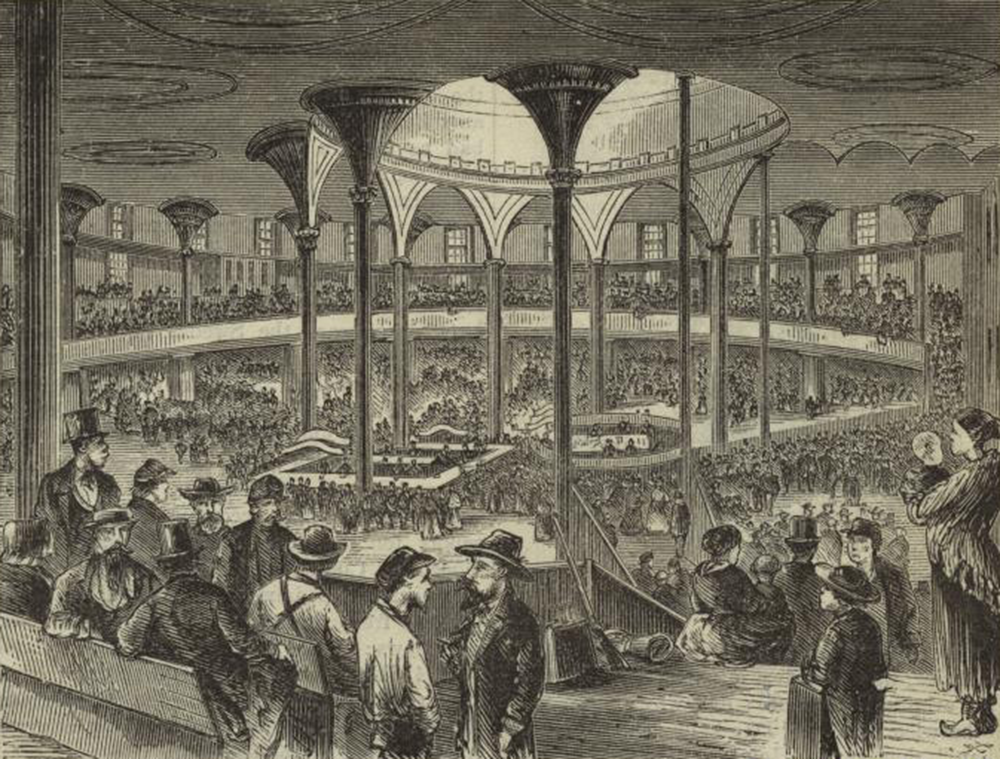
The Emigration Board required an incoming ship to anchor in the Narrows between Brooklyn and Staten Island so that officials could board it and look for any signs of infectious disease among the passengers and collect a copy of the passenger list. Traffic was constant year-round but typically peaked in May and June. In 1867 Emigration Board agents inspected 404 steamships and 245 sailing vessels carrying over 245,000 passengers. With this kind of volume, inspections had to be cursory, but any sign of contagion could lead to the quarantining of the steerage passengers or even the entire ship. Agents processed the paperwork of those in first-class cabins on board, allowing them to remain on the vessel as it proceeded to its pier. Steerage passengers found themselves and their luggage loaded on to barges or steamboats that took them to Castle Garden. After disembarkation at the depot, doctors inspected the newcomers, pulling aside those with noncontagious medical issues. Minor problems would be treated at an aid station on site, but those with more serious conditions would be sent by steamboat to the board’s immigrant hospitals on Wards Island in the East River for free treatment. Board officials claimed that the facilities there constituted the largest hospital complex in the world.
Immigrants who passed the medical exam would queue up to be registered by clerks who spoke multiple European languages and collected data including name, age, place of origin, profession, final destination, and how much money the person was carrying. The great majority of arrivals sought to move quickly to the interior, and an information bureau provided advice on how best to reach their destinations. Immigrants then could proceed to booths to buy tickets for railroads and steamboat lines, and also to a station for checking in luggage to its final destination. They could also take advantage of a concession offering cheap food, a letter-writing and telegraph department, a currency exchange, a waiting room, and bathing facilities. A labor exchange offering job opportunities proved especially popular with wealthy New York families seeking to hire young Irish women as domestics. Most new arrivals found themselves inside Castle Garden only for a few hours. After buying tickets, they were whisked by steamboat up the Hudson River to railroad, steamship, or canal-boat depots to continue their journeys. Others intending to meet friends and family in the city would have their names announced to awaiting crowds outside Castle Garden’s gates. One can only imagine the countless emotional reunions that took place there.
From the 1860s through the 1880s, Castle Garden became iconic not only as a landmark but also as a symbol of debates over immigration and an object of public fascination. Journalists, sketch artists, novelists, and painters regularly made the immigrant masses flowing through the depot the subject of their work. Newspapers reported weekly statistics on arrivals and the business of the Emigration Board. In 1871 one journalist ventured inside and observed a Swede in his “tanned-leather breeches and waistcoats,” an Irishman in his “napless hat, worn coat, and corduroy trousers,” an Englishman in his “Scotch cap, clay pipe, and paper collar,” and a German in his “dark blue woolen coat, high-necked, and brass-buttoned vest, and flat military cap.” Writers created a whole mini-genre of newspaper pieces detailing the variations in costumes and manners of newcomers as they trudged through Castle Garden, akin to birdwatchers distinguishing plumage.
More than one observer took note of the odor. Voyagers had just disembarked from a long journey in the steerage decks with no bathing facilities or refrigeration for foodstuffs. In 1867 an onlooker offered this visceral olfactory description: “A deadening, stifling smell greets the nostrils as you enter the hall, almost overpowering…You can faintly detect sauerkraut, decayed bologna, boiled butter, peanuts, unwashed women, the odor of venerable hams, boiled corn beef and cabbage, onions, rancid cheese, and many other kindred stenches.” Castle Garden offered separate bathing facilities for men and women, but no records exist of how often new arrivals used them.
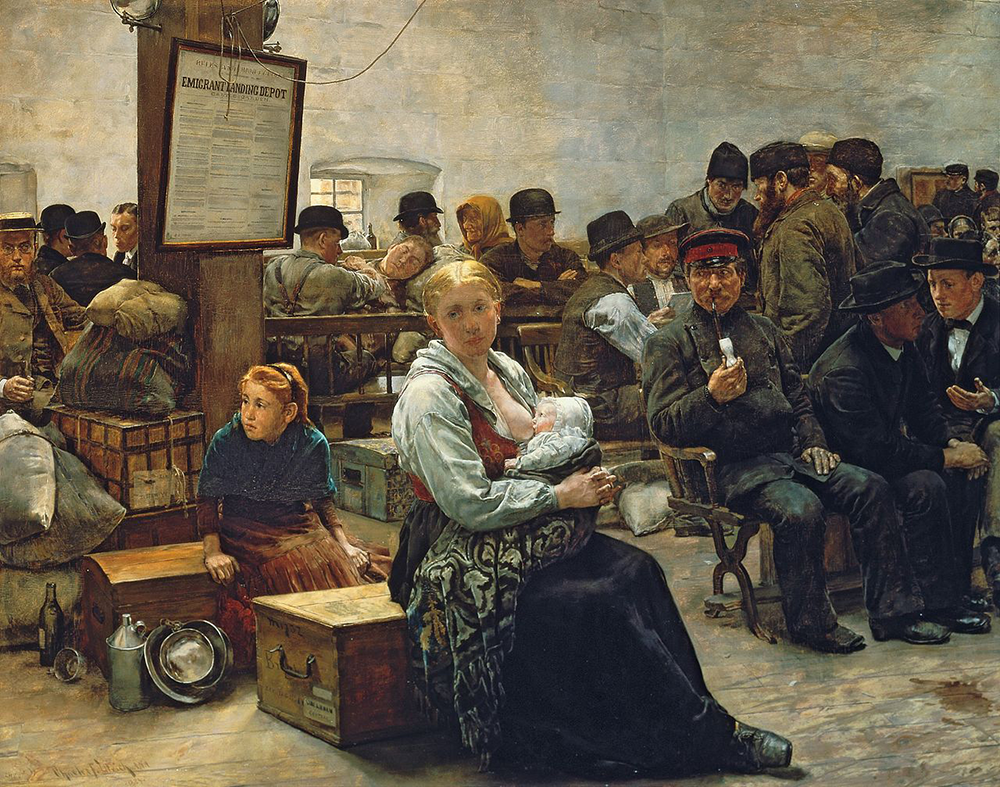
The era’s great illustrated newspapers, such as Harper’s Weekly and Frank Leslie’s, frequently had their artists capture the masses of humanity being inspected, going through the registration process, and buying tickets for inland destinations. In 1884 German American painter Charles Frederic Ulrich won acclaim for his work In the Land of Promise, Castle Garden, featuring a worried young immigrant breastfeeding her infant in a waiting area. (Ulrich served as a commissioner on the Emigration Board in the 1880s.) German painter Hubert von Herkomer painted a similar but more chaotic scene that same year in his Pressing to the West: A Scene in Castle Garden.
Many written accounts of Castle Garden reflected a mixture of civic pride and awe. In 1857 one observer noted that the amenities and protections provided by the new depot had transformed New York, “which till recently was the worse place at which an immigrant could be landed on the American coast, to the best.” In 1865 another extolled, “The gateway of the vast Western prairies is the Castle Garden portal; the entrance to the boundless resources of the Continent is the sliding-door at the Battery.” In William Dean Howells’ 1890 novel A Hazard of New Fortunes, the Marches, a bourgeois couple who had recently relocated from Boston to New York, passed by Castle Garden and were heartened by “the friendly care the nation took of these humble guests” and the “conscientious civility” of the officials overseeing the process. Journalists also revealed corruption and maltreatment of immigrants by Emigration Board agents, but even as the quality of care Castle Garden offered in the 1870s and 1880s fell off, newspapers still sent reporters to wonder at the scene. As late as 1889, a journalist writing for Joseph Pulitzer’s The World—whose editors were some of the Emigration Board’s harshest critics—marveled:
About two thousand immigrants were enjoying the genial May sunshine on the water dock of Castle Garden and in Battery Park yesterday. They were from every part of Europe from the north of Norway to the toe of Italy, and from Limerick to Warsaw. They were of every age, from the bent and white-haired woman, whose hands shook with palsy, to the babe that was born on the voyage and, so to speak, rocked by the ship.
Despite being one of the most recognizable structures in the nineteenth-century United States, Castle Garden barely registers in our historical memory today. The reasons why are numerous, but a few stand out. First, the depot and the Emigration Board experienced a long and slow decline through their last two decades of operation, exacerbated by bitter partisan politics over patronage and corruption. Second, past generations of historians have passed over the Emigration Board’s story in favor of the landmark year of 1882—bringing the federalization of immigration control and the passage of the Chinese Exclusion Act—which provides a more convenient and less complicated narrative starting point to discuss the history of immigration regulation. Third, government aid for white people has a tendency to be rendered invisible in our historical narratives about the United States. From the republic’s beginning, economic independence and the capacity for self-support determined access to citizenship rights; within this ideological framework, government assistance weakens claims on citizenship. The story of the Emigration Board and its welfare state runs contrary to the myth that whites have always pulled themselves up by their own bootstraps and challenges any presumed “naturalness” of white fitness for citizenship.
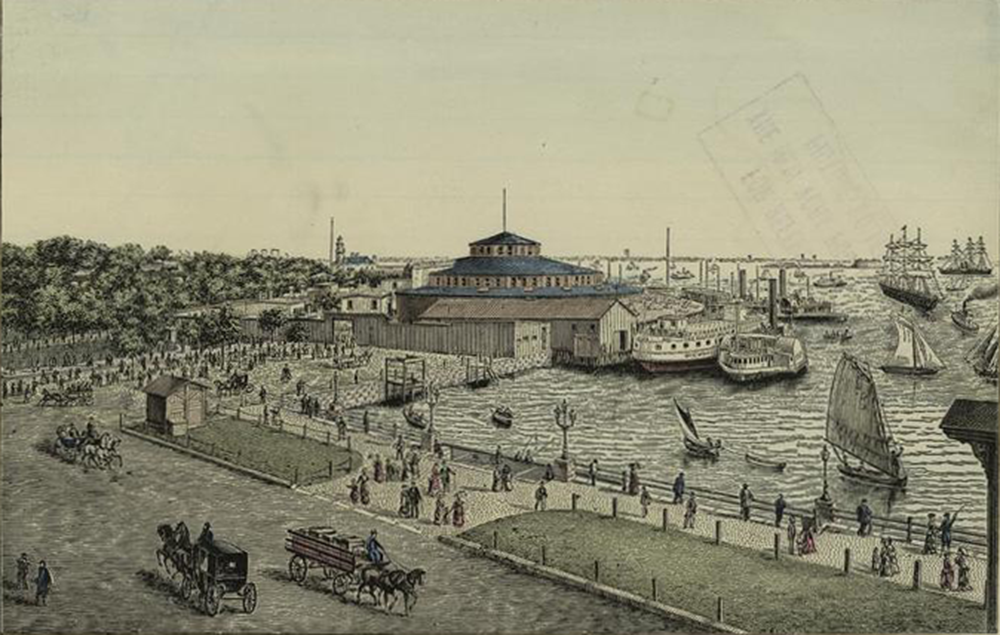
The Emigration Board’s decline began in 1870 when William M. Tweed and his corrupt ring reengineered the Emigration Board into a machine for patronage and graft. The job of commissioner—always unpaid in the past—became a salaried sinecure. The previous board’s commissioners, picked from the ranks of highly respected merchants and professionals, were replaced by Tammany hacks who doled out jobs as patronage. After the fall of the Tweed ring, lawmakers restored the board to its old form in 1873, but its reputation never recovered. Throughout the post-Tweed era, governors often chose commissioners for their party loyalty rather than their expertise in social welfare. For example, Edmund Stephenson, a low-level Republican hack, served as a commissioner in the 1870s and 1880s. He had worked as a bank teller before securing the presidency of a shady new bank in 1883. In 1887 the World accused him of forcing railroad companies that did business in Castle Garden to make deposits at his bank and personally subjecting female immigrants to indecent examinations before allowing them to land. Despite these accusations, he held on to his position until the board was disbanded.
Even more troublesome than the poor character of certain commissioners was the country’s plunge into a vicious economic depression by the mid-1870s, which caused immigration to plummet. With little head tax to collect, the board’s finances slid deep into the red. An 1876 U.S. Supreme Court case, Henderson v. New York, applied what appeared to be a coup de grâce: the justices ruled that a state or local authority collecting taxes on overseas trade (including passengers) violated the Commerce Clause of the Constitution, which grants the power to regulate foreign commerce solely to Congress. Without a source of revenue, the Emigration Board became a supplicant agency, dependent on emergency funding from the state until Congress federalized immigration control in 1882.
The conversion of the immigrant passenger trade from sailing vessels to gigantic iron-hulled steamships also overwhelmed Castle Garden. Wooden-hulled vessels would carry a few hundred steerage passengers at most, but some steamships could carry over a thousand. When transatlantic immigration rebounded in the 1880s, the chaos within Castle Garden became so notorious that Eastern European Jews incorporated the term kesselgarten into American Yiddish to mean any noisy and tumultuous place. The Treasury Department subcontracted the board to operate the Castle Garden regime in New York until 1890, when a federal inquiry determined that the depot was inadequate and ordered its closure and initiated plans for the Ellis Island station to replace it.
The United States has become a very different place than it was in the second half of the nineteenth century. The manufacturing sector that absorbed so much immigrant labor in the past is a fraction of what it was, but the U.S. economy still needs immigrants to function, especially in fields like health care, construction, and food service. Yet the current byzantine immigration system denies this reality, impeding the flow of needed workers with arbitrary and racist criteria that have accrued over the past century. Starting in the period of the Emigration Board’s decline through the passage of the Immigration Act of 1965, the operating logic of immigration policy was based on racial and ethnic exclusion. The 1965 act did away with the most egregious racism of the 1924 system but left arbitrary quotas intact, and for the first time imposed them on Latin American countries. Policy makers would benefit from a reexamination of the mostly forgotten New York Emigration Board, founded before the country entirely embraced a national system of exclusion based on race and ethnicity. The New York regime was far from perfect, frequently marred by corruption and other abuses, but its pragmatic and humane approach to immigration is one worth revisiting as we begin to imagine what immigration regulation should look like in the future.